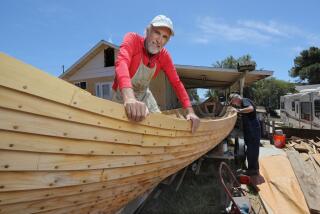Now It’s Nina’s Turn to Be Discovered : The replica of Columbus’ favorite ship docks in Long Beach. Visitors are welcomed on board to learn more about the famous explorer.
- Share via
Christopher Columbus never made it to the West Coast, but half a millennium after he discovered the New World for King Ferdinand and Queen Isabella, his favorite ship sails the Pacific blue.
It’s not the real thing, of course, but a 93-foot replica.
Crafted completely by hand, the Nina docked Wednesday in Long Beach at Shoreline Village’s downtown marina for 12 days in port. It arrived already a star: Its credits include the Ridley Scott film “1492.”
Through April 8 visitors can tour what Archaeology magazine has called “the most historically correct Columbus replica ever built.”
“People are flabbergasted by how much they learn,” said captain Morgan Sanger who sold his Virgin Islands shipyard to assume the Nina’s helm. “They know Christopher Columbus, they know the names of his ships, but they don’t know all of the really interesting things.”
Such as: By the time Columbus got the Nina, the Pinta and the Santa Maria, they were old and in need of constant repair. After all, they were going to fall off the face of the Earth, so the king and queen of Spain were not about to sacrifice the best of their fleet.
And on the first voyage, Columbus had to pull into the Canary Islands because the Pinta was having steering trouble. It was there that he decided to sail with the trade winds and re-rigged the Nina’s foremast and mainmast with square sails, the better to hold the breeze.
Below deck were horses, cows and pigs suspended in slings. A crew of about 25 slept on the 66-foot deck wherever they could. The Nina’s second return voyage carried more than 120 people--Spanish settlers who didn’t want to stay.
*
On board this time is Oscar Cherry, assistant fire chief in Bowling Green, Ky. He happened upon the Nina docked on the Ohio River and pestered the captain to hire him for the recent 34-day voyage from Brownsville, Texas, through the Panama Canal to San Diego.
Cesar Sarmento has been with the ship all along, traveling more than 75,000 miles with the Nina since December 1991, when the vessel left the banks of the Una River in Valenca on the coast of Brazil. A fisherman at home, he is first mate on the ship his family built.
Eighth-generation Portuguese shipwrights worked naturally shaped timbers with only adzes, axes, handsaws and chisels. They fashioned the keel from a single piece of wood in crafting the 15th century caravel, a common Age of Discovery trading vessel appreciated by both explorers and pirates for its speed and maneuverability.
The Nina’s hull is in the Scandinavian style, her rudder reminiscent of a Chinese junk’s. A Brazilian textile mill in business since the 17th century made the nearly 2,000 square feet of sail--all hand-stitched.
Built without blueprints in the manner of 15th century shipwrights, the replica emerged after much research for the Columbus Foundation by American engineer and maritime historian John Patrick Sarsfield.
The group of historians, nautical archeologists and tall-ship sailors based in the British Virgin Islands had dreamed of re-creating all three of Columbus’ ships to commemorate the 500th anniversary of his voyage in 1992.
The flagship Santa Maria was a freighter and not much missed by Columbus when she ran aground and sank. “She was very heavy and not suitable for the business of discovery,” he wrote in his journal. The Pinta was a caravel like the Nina, but she disappeared from history without a trace after the first voyage.
It was the Nina that especially enchanted the explorer. After the first voyage, he bought a half-interest in her and deemed her the flagship of a 117-ship colonizing voyage to the New World.
So, when the foundation found itself with less funding than expected, it was the Nina that the group decided to build.
Half of the $600,000 cost was covered by a private loan that the foundation is still repaying. It charges a small admission fee for tours of the ship.
“When vessels go into a maritime museum, it’s the end of their stories,” Sanger said.
“They are static, dying, no one looks after them. But at sea, they go on. This is the only authentic 15th century caravel. It’s important that people see it.”
More to Read
Sign up for The Wild
We’ll help you find the best places to hike, bike and run, as well as the perfect silent spots for meditation and yoga.
You may occasionally receive promotional content from the Los Angeles Times.





